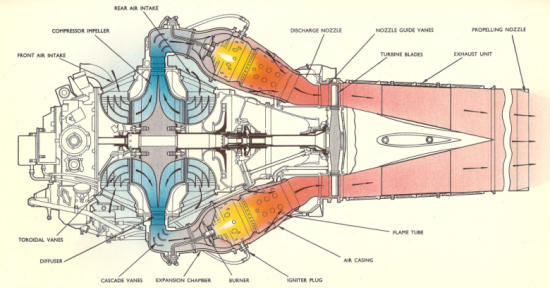Edis wrote:dren wrote:
Probably a 'poor' source, but I was reading the wiki page for individual stages for axial compressors. The 'over 2' is for research compressors, at supersonic speeds. Yes a stretch, but that's what it states. Ron Dennis went on and on about the tech never used before on this PU at the season start, so maybe there is some validity to this?
But I am a bit unsure as to the air speed, is it talking about how fast the vehicle is moving (incoming air speed) or about velocity through the compressor? I'm guessing the former. Which really puts us into the range of PR at 1.2 on the high end.
http://en.wikipedia.org/wiki/Axial_compressor
This comes from a chart on that page:
Industrial Subsonic 1.05–1.2 88%–92%
Aerospace Transonic 1.15–1.6 80%–85%
Research Supersonic 1.8–2.2 75%–85%
It's the speed of the incoming air relative to the blade speed, at the tip of the blades.
dren wrote:Blackout wrote:And the compressor is smaller like the honeywell dual-boost TC?

Dren might be right; the compressor might be radial and it's just smaller...
I kept thinking the dual boost was dual stage, even though the wheel is basically back to back compressor wheels. Or does the dual boost not qualify as dual stage?
Double sided impellers are single stage. This design was used on some early jet engines, like the Goblin
http://www.cairdpublications.com/scrap/ ... lin550.jpg
PlatinumZealot wrote:Sasha wrote:That is why I would put my money on a Mixed-Flow compressor
Still at least two stages.
For anybody that is curious it is a mix of axial and radial. normally used in helicopter engines and such.. pretty obvious it is two or more stages of compression. And would not in any way change the exducer diameter of the radial part. So I rule this one out.
http://www.kutriebresearch.com/wp-conte ... -Stack.jpg
That's not a mixed flow compressor, but a multistage axial with a final radial compressor stage.
This picture shows the difference between a radial and a mixed flow turbine, the principal is the same with compressors. A mixed flow compressor have a discharge that is not fully radial but neither fully axial.
http://www.full-race.com/store/images/f ... ent-11.jpg
It IS a mixed flow compressor no matter how you look at it. Even your own post suggest that it is.
You are being a bit literal but, Edis you are correct that street car compressor wheels are mixed flow. To the chagrin of some here,
I already know that the typical radial compressor is mixed flow 
(sorry guys). The thing is, the common radial compressor is not called mixed flow these days. For the masses here, I used that photo because I know that is
what he meant ( a more pronounced combination of axial then a radial).
I have worked with double sided pump rotors before... Your typical domestic booster pump is double sided. Basically two pump rotors in one if you ask me.. they also deliver high higher pressure ratios. In my post, I said it can be argued to be two compressors. One gas path going in the splits into two different gas paths then joins back again. Heck you can even put two different blade designs on either side if you want. I have no idea what would be the dynamic results of that though. But again
in my opinion dual boost can be argued to be two compressors. Why? because say, for example if you stuck two regular compressor wheels on the same shaft facing the same direction instead of back to back, by the wording of the rules it would be no different from a "dual boost" compressor. And yes it would be can be said to be a single stage too... (one step in compression). So it would be up to the FIA to clear this up...
Guys do you realize you have discovered a loop hole!






